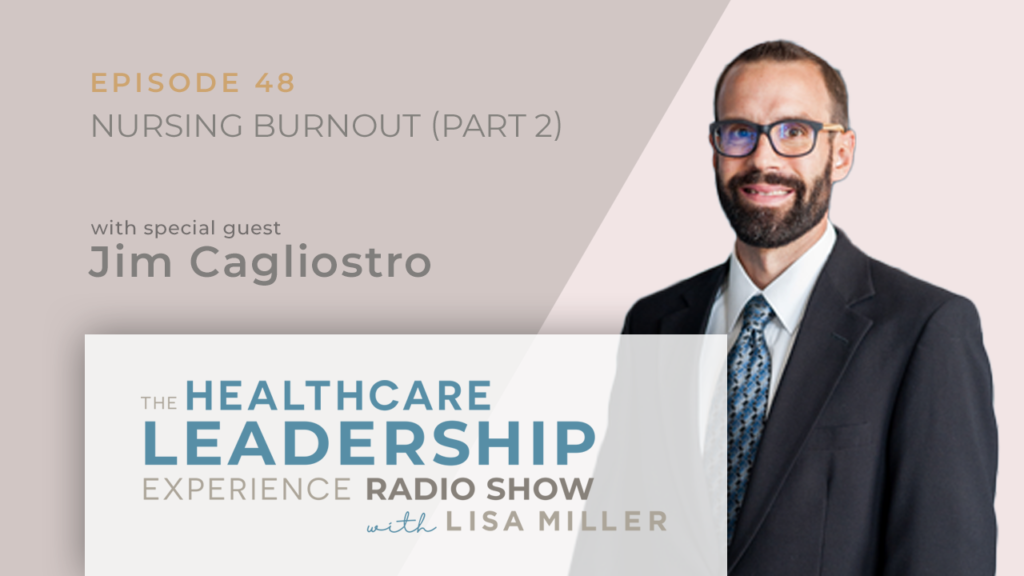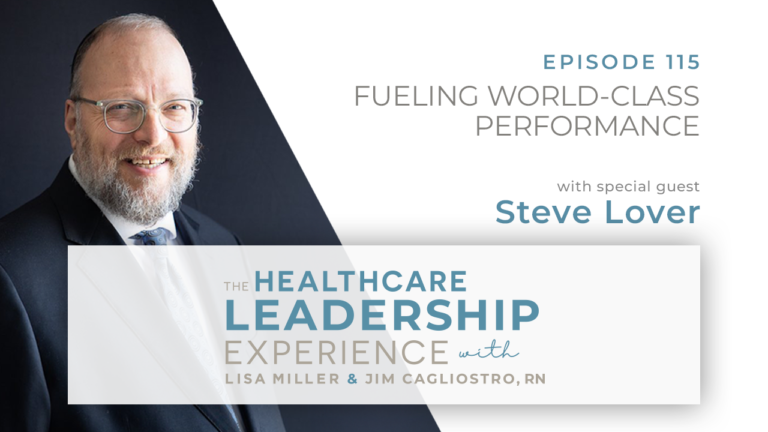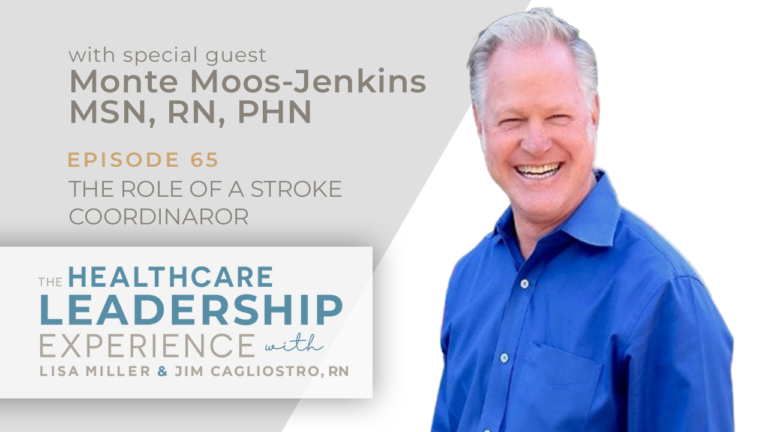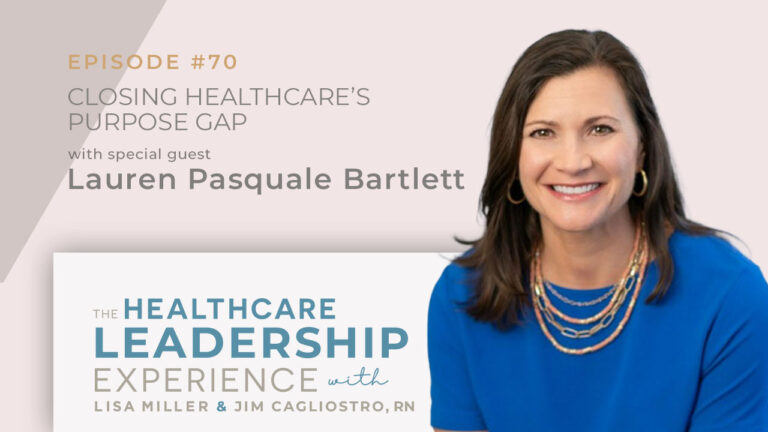In Episode 48 of The Healthcare Leadership Experience, Lisa is joined by Jim Cagliostro, a Registered Nurse and VIE’s Clinical Operations Performance Improvement Expert. Together they continue to discuss the role of nursing in healthcare, with a focus on the challenges of burnout.
Episode Introduction
The role of nursing has undergone a transformation in recent years. In this second episode of a two-part discussion, VIE Healthcare Consulting’s founder and CEO Lisa Miller interviewed Jim Cagliostro to explore effective solutions for burnout, and the benefits of frontline-driven innovation, and encourage all hospital leaders to listen to their nursing teams.
Show Topics
- Patient care assistance enables nursing staff to focus on their strengths
- Volunteers can enhance the patient experience
- Cost effective staffing solutions to overcome burnout
- Healthcare needs leadership that listens – and shows up
- Lessons for the healthcare sector from Undercover Boss
- The concept of shared governance
- When leadership doesn’t listen: an example from a patient’s bedside
02:13 Patient care assistance enables nursing staff to focus on their strengths
Jim shared his experience on the benefits of patient care assistance.
‘’And so I mentioned that patient care assistance. And by that, for anybody, most people know, these are people that are trained in terms of what’s the safe way to help a patient who’s had a certain procedure to help them to the bathroom, or to sit them up or get them over to the chair and set them up for a meal. For recognizing, “Okay, there’s certain restrictions that this patient has. So I can go get a drink of water for this patient, but that one needs thickener in their liquid.” Or when do we need vital signs and daily weights. These are all activities that patient care assistants or nurse assistants, depending on where you’re at, they have different names, that they can help with. And then it allows nurses to focus on the things that only the nurses can do.’’
04:28 Volunteers can enhance the patient experience
Lisa shared a personal experience of her daughter’s stay in hospital.
‘‘My daughter was in the hospital, and we were in a children’s wing of a hospital. And it’s interesting, because I think that anything to do with children, people tend to be more innovative….But this young man that came in, and I would say he was about 17 or 18, and he would just come into the room and talk to me, talk to my daughter, and really just chatted with her. And he is like, “Oh, I’ll go get coloring books and I’ll color with her.” And I’m just like, “Okay, who are you?” I’m like, “This is great.” I mean, he was great. I mean, I knew he had a badge and I knew he was there legit, but I’m like, “What’s your role? You got to tell me your story. What’s going on here?” And he’s like, “Oh, I’m going to start medical school and I have a program here at the hospital where I can volunteer.” And he wanted to be a pediatric orthopedic surgeon, which is amazing, because he was not even in medical school and he knew what he wanted to be, but of course that made a change.’’
06:56 Cost effective staffing strategies to overcome burnout
Jim said improving nurse-to-patient ratios was just one way of better managing resources.
‘Every state should, I don’t know if every state does, but states will have a minimum nurse-to-patient ratio. And so if you have this number of patients, then you need this number of nurses. So that’s one thing… They have to meet that as a minimum, but they can have better standards in terms of, “Okay, the state says five-to-one or four-to-one on this step down unit. But we, as a hospital, are going to say, ‘No, we’re going to say three patients to one nurse, because we want to provide better care. And yeah, it’s going to cost us more maybe upfront, but in terms of the quality of care, in terms of safety, in terms of preventing falls or infection or things like that, it might end up saving us money in the end if we have a better nurse-to-patient ratio. And then the other thing you touched on was staffing and managing the resources. In this case, managing your personnel, the nurses, in a better way. And a lot of hospitals will have a float pool to say, “Okay, we know of this 500-bed hospital, there’s going to be 10 to 15 nurses that call off each night.” For whatever reason, sickness or whatever happens. So now we have a float pool that is coming in every night. And this float pool, instead of staffing it with eight nurses per night, we’re going to say, “Let’s have 12 to 15 nurses coming in, ready to fill those gaps.”
11:01 Healthcare needs leadership that listens – and shows up
Jim believed it is beneficial for hospital leaders to engage directly with nursing teams during their shifts.
‘’When it comes to leadership that listens, I would say, in my mind, probably the key there is leadership that’s initiating the conversation. Because a lot of times the busyness of what’s going on on the floor, and sometimes you don’t even know where to start in terms of, “Well, how do I reach out to …” Usually a manager. Sure, if there’s a manager of a unit, you’ll see them. But sometimes on night shift, I worked night shift much of my career, you don’t necessarily see your manager, except in passing when they’re running to start the day. So I think it’s good, whether it’s from the unit manager or from the director of your department, or from even higher up, the C-suite, to see that they’re initiating the conversation. And there may be even walking onto the floor at change of shift, maybe that’s a busy time to do it. But touching the day shift and the night shift and saying, “Hey, we are here to listen. What concerns do you have?”
12:43 Lessons for the healthcare sector from Undercover Boss
Lisa outlined the concept of Undercover Boss and its potential benefits for healthcare.
‘’I’ve watched several episodes, but Undercover Boss. It just gets me thinking every single time, it would be very difficult for a hospital CEO or someone in the C-suite to do an undercover, but they probably could. And it’s always the same story. It’s someone’s owner, leader, and is going undercover in their own organization, completely disguised. And they’ve got to do jobs that they know nothing about and they have to learn and they’re clumsy through it. Meanwhile, it’s their own business or the business that they run. And they meet people and they hear stories on the front lines where they see things that have to be changed…. I’ve just given everyone the episode, it’s just a matter of what do they see differently. What stories do they hear and how they’re touched by it. But it’s so fascinating to me that every organization has these stories, has these people. And why aren’t we just doing it regularly, just making it part of your routine, your weekly routine. “I’m going to go to this floor and have those conversations.” So you just got me thinking about Undercover Boss, binge watching.’’
15:08 The concept of shared governance
Jim said shared governance offers nurses a voice, but communication is essential to avoid frustration.
‘’There’s something, a concept, and there might be different names for it. But one place that we saw had something called shared governance. And so that’s something where they bring in nurses from various areas of the hospital to come together. And this one particular hospital they met monthly. And one thing was the pre-op checklist was something that they were working on, “How can we make this better? How can we make it more efficient? How can we really make it so it’s the best for the patient and the best for the staff?…And they worked on this for months and it’s something that … Changing in the language, adding things here, taking things away there. And unfortunately, the concept of shared governance was great because it was in place there, and they said, “Okay, we want the nurses to have a voice.” But then the decisions that were made ended up going up the chain of command and back down, and ultimately no change was made….. ‘’
“There needs to be something, even the conversation from the higher ups to say, “Hey. Well, this is why we didn’t go with those changes.” But that can be very frustrating for staff that has poured in their time and their energy in terms of saying, “Okay, we have a voice, we have this concept of shared governance. Well, is it really making a difference?” And I think the responsibility ultimately does fall on leadership to say, “Okay, we want to listen. And we want to make changes based off what the front line is telling us.”
17:47 When leadership doesn’t listen: an example from a patient’s bedside
Lisa shared a second experience from her daughter’s stay in the hospital.
‘’My daughter was in the hospital and I had to take her into the bathroom. Now this was a new wing, so I had to have her IV pole in. I couldn’t get her IV pole in, nurse said, “They didn’t ask us any of this. They didn’t come through here.” There was something particular about the IV pole and we just couldn’t get it in. And I’m like, “Wow, this is brand new.” And they were like, “Yeah.” The door closed the other way and it was just awkward and like, “Oh, they didn’t ask the nurses anything about the rooms.” And I’m like, “Wow, that’s so fascinating.” If architects and engineers are really smart people, yet you don’t go to those who are working to say, “How does this flow’’…. But there’s so many lessons here in this discussion, and you just wonder why it takes burnout, COVID, frustration, for us to be at this place. And it’s unfortunate, because so many of these fixes I think could be really easy. And I don’t mean flip the switch on easy, but they’re solvable. These are not unsolvable challenges.’’
Show Links
📱 Connect with Jim Cagliostro on LinkedIn
📱 Connect with Lisa on LinkedIn
🖥 Check out VIE Healthcare Consulting
You’ll also hear:
- How secretaries and volunteers can help to alleviate levels of burnout among nursing staff. ‘’Volunteers can really help lighten that burden and really provide an excellent experience for patients.’’
- Don’t just match the float pools: Why doubling up is an innovative and cost effective way to reduce the pressure on nurses.
- ‘’Have you ever seen a CFO walk the floors on a night shift?’’ Why showing up on the hospital night shift and listening to concerns could make a difference to burnout.
- Hospital executives need to discover what they can do to help to improve the role of nurses and enhance patient care.
- The need to treat every patient like a VIP. ‘’I was caring for someone who ended up being the head of anesthesia in the hospital that I was working, and didn’t realize it… but we need to be treating every patient like they’re someone extremely important.’’
- The frustration nurses feel when their suggestions and efforts are unrecognized or discarded. ‘’And you realize, well, do we really have a seat at the table? Is anybody really listening?’’
- Why frontline-driven innovation offers huge benefits for every health system. ‘’No one knows best than those in the front lines. I’m a big believer in frontline-driven innovation. And I think that needs to be tapped and harnessed a lot more.’’
What To Do Next:
- Subscribe to The Cost Advantage for Healthcare Leaders and receive a special report on 15 Effective Cost Savings Strategies.
- Learn more about the simple 3 step process to work with us.
- If you are interested in learning more, the quickest way to get your questions answered is to speak with one of our margin improvement experts. Schedule a call with our team.
Episode Transcripts
CLICK HERE TO DOWNLOAD THE PDF TRANSCRIPT
CLICK HERE TO OPEN THE TRANSCRIPT
Introduction (00:02):
Welcome to the Healthcare Leadership Experience Radio Show with your host, Lisa Miller. Lisa is an entrepreneur, inventor, advisor and founder of VIE Healthcare Consulting, the leading healthcare advisory and analytics firm, helping hospitals accelerate their margin improvement goals.
Lisa loves to think differently and collaborates with leaders and their teams to solve challenges and to create new innovative approaches that impact the clinical and business side of healthcare. Our show will bring you leaders and innovators within healthcare and across multiple industries.
Be a part of the discussion that will give you a unique perspective, deep insights, and roadmaps to successfully help you navigate the clinical, financial, and operations of healthcare. Your show starts now.
Lisa (00:48):
Welcome to the Healthcare Leadership Experience Radio Show on HealthcareNOW Radio. I’m Lisa Miller, your host. And today we welcome back to the show Jim Cagliostro from VIE Healthcare for part two of our discussion on nursing.
Jim, I’d like to pick up right where we left off. You’ve given us a list, some things that needed to be looked at that could reduce burnout for nurses. Let’s dig into that list and start off by talking about support staff.
Lisa Miller (01:15):
They all are fantastic, and I want to talk about a few of them in detail, but support staff. Can you just talk about their support staff aids now, do you think there’s other support staff? Like you made a comment about the bells, people ringing, and do you think there’s anything else that … And I’m completely putting on the spot here-
Jim Cagliostro (01:35):
Sure, sure.
Lisa Miller (01:35):
… but do you think there’s any other support staff that doesn’t exist or maybe exist a little bit that could exist more? Because I think that’s really important, right? We talk about it on the business side, is nurses shouldn’t be putting away stock, that’s not a good use time. And maybe they want to put away stock sometimes to get away and do something else. But maybe there’s support staff that helps them, even in that direct care. Do you have some thoughts, exist, doesn’t exist, could exist?
Jim Cagliostro (02:03):
Because I’ve worked in a number of different health systems in a number of different states, and my work with VIE, I’ve seen some places that do it great. And we’ve seen some places where, “Hey, there’s room for improvement here.”
Jim Cagliostro (02:13):
And so I mentioned that patient care assistance. And by that, for anybody, most people know, these are people that are trained in terms of what’s the safe way to help a patient who’s had a certain procedure to help them to the bathroom, or to sit them up or get them over to the chair and set them up for a meal. For recognizing, “Okay, there’s certain restrictions that this patient has, so I can go get a drink of water for this patient, but that one needs thickener in their liquid.” Or when do we need vital signs and daily weights. These are all activities that patient care assistants or nurse assistants, depending on where you’re at, they have different names, that they can help with. And then it allows nurses to focus on the things that only the nurses can do.
Jim Cagliostro (02:54):
And you touched on it, Lisa, where there’s activities that really can stretch someone. But if those activities can be delegated to someone else. I talked to my wife about this a lot. You know my wife, Lisa. And she’s very much the person I … “Well, it’s just quicker to do it myself. I’m just going to do it and get it done.” But really in nursing, we have to learn to delegate some of those tasks that can be done by others. But if the staff isn’t there, if there’s nobody there to delegate it to, then it ultimately falls back onto the nurse.
Jim Cagliostro (03:22):
Other things I’d say, I’ve worked in places they have a secretary, where it’s literally someone that answers the phone. Every call that comes into the unit, it goes to that person. And then they can triage the phone calls basically and say, “Okay, I can contact the nurse for this,” or, “This is something I can deal with,” or, “I can get the appropriate person.” So that really minimizes the need for, well, a nurse is doing patient care, well, they have to run over to the phone because somebody’s calling.
Jim Cagliostro (03:47):
And another thing is volunteers. I’ve worked at places that have a great system of volunteers. And sometimes patients just need someone to sit with them. I’m telling you, you know me, Lisa, I love on my 12-hour shift just to sit and chat with someone. And they’re lonely, they haven’t seen a visitor in a week — and they just need someone to talk to. They want to reminisce, or they want to talk about what they’re struggling with. Sometimes a volunteer just to come and sit with someone, get them a newspaper, go down to the snack shop and get them a snack. Things like that, where again, nurses can focus on the responsibilities that they’re able to address. And volunteers can really help lighten that burden and really provide an excellent experience for patients. Those are a few things that come to mind off the bat.
Lisa Miller (04:28):
Yeah. I love the volunteers. And I had a personal experience. My daughter was in the hospital, and we were in a children’s wing of a hospital. And it’s interesting, because I think that anything to do with children, people tend to be more innovative. And you really could do the same thing anywhere really in a hospital but we tend to, for obvious reasons, to be more innovative. And it’s not maybe they understand the environment and they’re little.
Lisa Miller (04:53):
But this young man that came in, and I would say he was about 17 or 18, and he would just come into the room and talk to me, talk to my daughter, and really just chatting with her. And he is like, “Oh, I’ll go get coloring books and I’ll color with her.” And I’m just like, “Okay, who are you?” I’m like, “This is great.” I mean, he was great. I mean, I knew he had a badge and I knew he was there legit, but I’m like, “What’s your role? You got to tell me your story. What’s going on here?” And he’s like, “Oh, I’m going to start medical school and I have a program here at the hospital where I can volunteer.” And he wanted to be a pediatric orthopedic surgeon, which is amazing, because he was not even in medical school and he knew what he wanted to be, but of course that may change.
Lisa Miller (05:36):
I thought it was fantastic. You wonder whether the volunteer from a traditional community or those young people who are going into medical school, what a great way to say, “Listen, this is a great way for you to learn a little about direct patient care and doing some volunteer work.” But he was fantastic. He took his volunteer work very seriously.
Jim Cagliostro (05:59):
And that one person can change the entire experience for your daughter, for the whole family.
Lisa Miller (06:03):
Yeah.
Jim Cagliostro (06:03):
That’s wonderful to hear stories like that.
Lisa Miller (06:05):
Right. And you just wonder how many more of those that happen throughout the country, and you just get everybody learning and implementing. It’s the other thought that always is in my head, is you’ve got all these great models or systems and experiences or things that nurses are doing. And we just need this big pool of putting those ideas in so people can take them out and bring them to their own hospital, because I think there’s so many of those throughout the country.
Jim Cagliostro (06:35):
Oh yeah.
Lisa Miller (06:35):
All right. We’re going to dig in a couple or more. Better staffing, so that’s something that seemingly could be fixed easily in the sense that sometimes it’s poor planning, poor management. Sometimes it’s real and just as a series of events and there’s staffing shortages. But my guess is some of it’s just could be better at staffing, right?
Jim Cagliostro (06:56):
Yeah. Three things come to mind. One is state laws. Every state should, I don’t know if every state does, but states will have a minimum nurse-to-patient ratio. And so if you have this number of patients, then you need this number of nurses. So that’s one thing.
Jim Cagliostro (07:11):
But a hospital doesn’t necessarily have to meet the … They have to meet that as a minimum, but they can have better standards in terms of, “Okay, the state says five-to-one or four-to-one on this step-down unit. But we, as a hospital, are going to say, ‘No, we’re going to say three patients to one nurse, because we want to provide better care. And yeah, it’s going to cost us more maybe upfront, but in terms of the quality of care, in terms of safety, in terms of preventing falls or infection or things like that, it might end up saving us money in the end if we have a better nurse-to-patient ratio.
Jim Cagliostro (07:44):
They don’t have to meet exactly what the state is saying, they could provide a better nurse-to-patient ratio. And then the other thing you touched on was staffing and managing the resources. In this case, managing your personnel, the nurses, in a better way. And a lot of hospitals will have a float pool to say, “Okay, we know of this 500-bed hospital, there’s going to be 10 to 15 nurses that call off each night.” For whatever reason, sickness or whatever happens. So now we have a float pool that is coming in every night. And this float pool, instead of staffing it with 8 nurses per night, we’re going to say, “Let’s have 12 to 15 nurses coming in, ready to fill those gaps.”
Jim Cagliostro (08:22):
And again, that comes down to a healthcare system, making the decision to say, “Okay, we might have an extra nurse. Well, we can provide them to a unit that needs the help tonight, whatever they’re going through.” Or maybe there’s a code in one area and they can go and help in that area because a nurse isn’t available, things like that. It’s definitely managing personnel in a way that says, “Okay, patient care is a priority for us.” It’s not just saving where we can here and there, but we need to make sure that the hospital is staffed well.
Lisa Miller (08:53):
So, you just taught me something. It’s true, you always hear, “We’re meeting our requirements,” or, “The float pools are matching,” kind of historical analysis. But to say, “You know what, we want to be 25% greater than our needs on a float pool. We want to be greater with our ratios,” makes more sense. Everything you named, and happier nurses not leaving the profession or going somewhere else.
Lisa Miller (09:20):
It just seems like such a solid solution to say, “We’re going to do the opposite.” And sometimes, when we do the opposite, it ends up being better in a lot of different ways. Not following what everyone’s doing and saying, “Listen, we’re going to actually over-commit on nursing, over-commit on the float pools.” And it probably would have a tremendous impact, it would probably be way more cost effective.
Jim Cagliostro (09:43):
And that will trickle down. You think of the impact it would have on the staff, where you just see, “Hey, leadership cares about us.” But that’s going to impact the care that they provide to patients and patients are going to recognize that. That type of decision making, that type of prioritization, can really have an impact hospital wide, system wide, if that’s something that people will see a difference. And it might take a while to see it, but people will see that difference.
Lisa Miller (10:08):
Yeah, I agree. I think they will.
Lisa Miller (10:10):
If you’re just tuning in, you are listening to The Healthcare Leadership Experience Radio Show on HealthcareNOW Radio. And I’m Lisa Miller, your host. This show was sponsored by VIE Healthcare Consulting, the leading healthcare advisory and analytics firm, helping hospitals accelerate their cost savings and margin improvement goals. We’ve been helping hospitals since 1999, and you can learn more about VIE Healthcare at viehealthcare.com.
Lisa Miller (10:33):
So, the last area, as we wrap up, is around leadership. You mentioned two things. You mentioned leadership that listens, I want you to expand on that, and having a seat at the table, because I think those two are really important. So if you can tell me what you mean by leadership that listens, and how hospitals can have nurses in leadership that have a seat at the table. If you can just expand on each of those.
Jim Cagliostro (11:01):
Definitely. When it comes to leadership that listens, I would say, in my mind, probably the key there is leadership that’s initiating the conversation. Because a lot of times the busyness of what’s going on, on the floor, and sometimes you don’t even know where to start in terms of, “Well, how do I reach out to …” Usually a manager. Sure, if there’s a manager of a unit, you’ll see them. But sometimes on night shift, I worked night shift much of my career, you don’t necessarily see your manager, except in passing when they’re running to start the day.
Jim Cagliostro (11:31):
So, I think it’s good, whether it’s from the unit manager or from the director of your department, or from even higher up, the C-suite, to see that they’re initiating the conversation. And there may be even walking onto the floor at change of shift, maybe that’s a busy time to do it. But touching the day shift and the night shift and saying, “Hey, we are here to listen. What concerns do you have?”
Lisa Miller (11:52):
Before we go to the next point, I’m sorry to jump in. Have you ever seen a CFO walk the floors on the night shift?
Jim Cagliostro (11:58):
Not a CFO. I know we’ve seen, I want to say the director of our department. I want to say director of perioperative services. I would cover until 1:00 AM in one particular hospital that I was working, and you would see them maybe eight or nine o’clock at night. So they’re catching the night shift, but not necessarily … Hey, you know what? I think, on Thanksgiving or Christmas one time I remember seeing someone like, they’re just greeting people. And it was somebody in the C-suite that was just there to say, “Hey, thank you for what you do.” So that’s great.
Jim Cagliostro (12:30):
But it’s something that I know didn’t happen often. And it depends on the system you’re in to say, hey, it’s not just, “Hey, thank you for what you do,” but asking questions. “What can we do to make your lives better? What can we do to help you care for your patients?”
Lisa Miller (12:43):
I’m going to go off on a little quick tangent here before we talk about or we end with getting nurses at leadership a seat at the table. I’ve watched several episodes, but Undercover Boss. It just gets me thinking every single time, it would be very difficult for a hospital CEO or someone in the C-suite to do an undercover, but they probably could. And it’s always the same story. It’s someone’s owner, leader, and is going undercover in their own organization, completely disguised. And they’ve got to do jobs that they know nothing about and they have to learn and they’re clumsy through it. Meanwhile, it’s their own business or the business that they run. And, they meet people and they hear stories on the front lines where they see things that have to be changed.
Lisa Miller (13:33):
It’s every episode. I’ve just given everyone the episode, it’s just a matter of what do they see differently. What stories do they hear and how they’re touched by it. But it’s so fascinating to me that every organization has these stories, has these people. And why aren’t we just doing it regularly, just making it part of your routine, your weekly routine. “I’m going to go to this floor and have those conversations.” So you just got me thinking about Undercover Boss, binge watching.
Jim Cagliostro (14:03):
Yeah. Well, on the flip side of that, I’ll just share a brief experience. I was caring for a patient. And if you have somebody that’s high up in the hospital or health system, but they’re a patient, I mean, every patient looks the same. We all look terrible in those patient gowns. But you walk in and you don’t necessarily know. You see a name and you see them in the gown. But I was caring for someone who ended up being the head of anesthesia in the hospital that I was working, and didn’t realize it until maybe going back and one of my coworkers mentioned it.
Jim Cagliostro (14:32):
But on that side of it, it’s like, we need to be treating every patient like they’re someone extremely important-
Lisa Miller (14:39):
Good point.
Jim Cagliostro (14:39):
… because every patient is someone extremely important. But it’s our human tendency, “Oh, this is someone that might be responsible for … Or someone that could make me lose my job. I better be on my best behavior.” While we, from a nursing perspective, need to have that attitude for every patient that comes through our doors.
Lisa Miller (14:53):
Yeah. That’s a great point.
Jim Cagliostro (14:55):
But that’s a another thing on the flip side of what you said, but the Undercover Boss thing is a great perspective.
Lisa Miller (15:01):
Yeah. No, and yours as well. It’s great. So as we wrap up, Jim, nurses in leadership that have a seat at the table, what does that mean to you?
Jim Cagliostro (15:08):
There’s something, a concept, and there might be different names for it. But one place that we saw had something called shared governance. And so that’s something where they bring in nurses from various areas of the hospital to come together. And this one particular hospital they met monthly. And one thing was the pre-op checklist was something that they were working on, “How can we make this better? How can we make it more efficient? How can we really make it so it’s the best for the patient and the best for the staff?”
Jim Cagliostro (15:38):
And they worked on this for months and it’s something that … Changing in the language, adding things here, taking things away there. And unfortunately, the concept of shared governance was great because it was in place there, and they said, “Okay, we want the nurses to have a voice.” But then the decisions that were made ended up going up the chain of command and back down, and ultimately no change was made.
Lisa Miller (16:00):
Yikes.
Jim Cagliostro (16:01):
Yeah, it’s a discouraging thing, where you spend all these hours and months really cleaning it up and making it right but then … At least in concept, there’s a seat at the table, but then when you see, “Hey, nothing was really done out of all these hours that were put into it.” And you realize, “Well, do we really have a seat at the table? Is anybody really listening?”
Jim Cagliostro (16:20):
So, there needs to be something, even the conversation from the higher ups to say, “Hey. Well, this is why we didn’t go with those changes.” But that can be very frustrating for staff that has poured in their time and their energy in terms of saying, “Okay, we have a voice, we have this concept of shared governance. Well, is it really making a difference?” And I think the responsibility ultimately does fall on leadership to say, “Okay, we want to listen. And we want to make changes based off what the front line is telling us.”
Lisa Miller (16:47):
Yeah, absolutely. I think that’s a great story. And it’s a heartbreaking, frustrating story to hear that, because people want to be part of change and innovation and really want to give their information and their hard work to collaboration, and then not to have any of it taken is not good.
Lisa Miller (17:04):
But the interesting part about that is that I think that’s another avenue for hospitals really to say, “Listen, how do we engage more?” I mean, engagement’s not just … It is for the people who are getting a seat, but it’s also a benefit to the organization. No one knows best than those in the front lines. I’m a big believer in frontline-driven innovation. And I think that needs to be tapped and harnessed a lot more.
Jim Cagliostro (17:29):
Yeah, I was just amazed by this. I forget where I heard it, but they were building a new section of the hospital or redoing it. And they said, “Nurses, come in,” and they were asking the nurses, “What is the best height for the outlets?” Something as simple as that, but the nurses are the ones plugging in and plugging out. So I love to hear examples like that, where they’re really listening.
Lisa Miller (17:47):
Yeah. Interesting, I had the reverse happen. Again, my daughter was in the hospital and I had to take her into the bathroom. Now this was a new wing, so I had to have her IV pole in. I couldn’t get her IV pole in, nurse said, “They didn’t ask us any of this. They didn’t come through here.”
Lisa Miller (18:03):
There was something particular about the IV pole and we just couldn’t get it in. And I’m like, “Wow, this is brand new.” And they were like, “Yeah.” The door closed the other way and it was just awkward and like, “Oh, they didn’t ask the nurses anything about the rooms.” And I’m like, “Wow, that’s so fascinating.” If architects and engineers are really smart people, yet you don’t go to those who are working to say, “How does this flow-“
Jim Cagliostro (18:27):
Those who are directly impacted by it. Yeah.
Lisa Miller (18:28):
Yeah. And I always remember that, because every time I brought my daughter in the bathroom I couldn’t get the IV pole in. It was like getting her in the bathroom and we’re kind of in between stretching the pole, and the nurse was like, “Yep, they didn’t ask us.” But there’s so many lessons here in this discussion, and you just wonder why it takes burnout, COVID, frustration, for us to be at this place. And it’s unfortunate, because so many of these fixes I think could be really easy. And I don’t mean flip the switch on easy, but they’re solvable. These are not unsolvable challenges.
Lisa Miller (19:05):
Jim, thank you for your time today. This was fantastic. I wish we could continue the conversation, but we’ve run out of time. However, we are having a conversation next week on the OR, and that’s going to be a great conversation so thank you for being here.
Jim Cagliostro (19:21):
Definitely. Thank you for having me. I’m looking forward to our next conversation.
Lisa Miller (19:24):
Great. You’ve listened to The Healthcare Leadership Experience. I’m your host, Lisa Miller, here on HealthcareNOW Radio. And join us every week, and we thank you for listening.
Outroduction (19:37):
Thank you for joining Lisa Miller for this episode of The Healthcare Leadership Experience Radio Show, sponsored by VIE Healthcare Consulting. If you enjoyed the show, subscribe so you can automatically get notified when new shows premier weekly. Don’t forget to leave us a review. Some more healthcare leaders like you can discover us. This show is on HealthcareNOW Radio, Apple Podcast, Stitcher, Spotify, Pandora, and other major podcast platforms.
To reach out to Lisa personally you can join the conversation on LinkedIn, where Lisa continues to have discussions on the business of healthcare. You can find links to Lisa’s other social platforms in the show notes or at viehealthcare.com.
The Healthcare Leadership Experience Radio Show is the think differently communication for healthcare leaders, and we are honored to have you tune in. Join us next week for another episode of The Healthcare Leadership Experience Radio Show.











